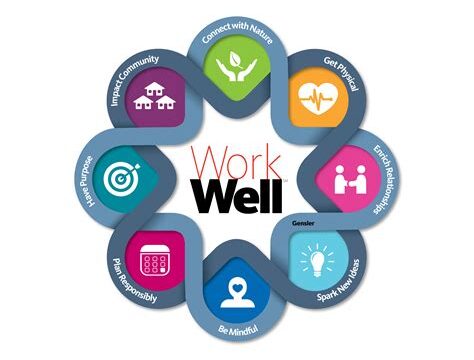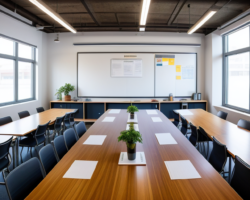In today’s fast-paced and ever-changing world, more and more people are finding themselves working from home. As a result, the importance of creating a home office that not only promotes productivity but also enhances mental well-being has become increasingly evident. From designing a calming and inspiring workspace to incorporating biophilic elements for natural serenity, there are numerous factors to consider when it comes to creating an environment that supports a healthy mind and body. In this blog post, we will explore the various ways in which you can design and organize your home office to promote peace of mind, productivity, and overall well-being. Whether it’s choosing the right lighting for optimal focus or implementing mindfulness practices for relaxation, we will cover everything you need to know to create a space that not only meets your professional needs but also contributes to your mental and emotional wellness. Join us as we delve into the essential elements of a home office that enhances mental well-being.
Designing a Calming and Inspiring Workspace
When it comes to creating a workspace that promotes a sense of calm and inspiration, there are a few key elements to consider. One of the first things to think about is the layout of the space. A cluttered and disorganized workspace can be distracting and stressful, so it’s important to keep things tidy and well-organized. This can help to create a more serene and peaceful environment to work in.
Another important aspect of designing a calming and inspiring workspace is the use of color. Soft, muted tones like pale blues, greens, and greys can help to create a sense of tranquility, while pops of color can add a touch of inspiration and creativity. It’s also important to consider the lighting in the space. Natural light is ideal, as it can help to boost mood and productivity, but if that’s not possible, soft, warm lighting can create a cozy and inviting atmosphere.
Ergonomics are also an important consideration when designing a workspace. A comfortable and supportive chair, an ergonomic desk setup, and proper positioning of computer equipment can help to prevent strain and promote better posture, leading to improved physical and mental well-being. Finally, incorporating elements of nature, such as plants or natural materials, can add a sense of serenity to the workspace, helping to create a more calming and inspiring environment.
By paying attention to these key elements, it’s possible to create a workspace that not only promotes a sense of calm and tranquility, but also inspires creativity and productivity.
Organizing and Decluttering for Peace of Mind
Organizing and decluttering your living and work spaces can have a significant impact on your mental well-being. When clutter begins to accumulate, it can lead to feelings of overwhelm and a lack of peace of mind. This can have a direct impact on your ability to focus and feel calm in your environment.
By implementing organization and decluttering strategies, you can create a more peaceful and harmonious space. This can involve purging items that no longer serve a purpose, creating designated storage areas, and finding a place for everything in your home or office.
Studies have shown that a clean and organized environment can lead to reduced stress and increased feelings of calm. When everything in your space has a purpose and is in its rightful place, it can help to clear your mind and create a sense of order.
Take the time to declutter and organize your surroundings, and you may find that it has a profound impact on your mental clarity and overall peace of mind.
Choosing the Right Lighting for Productivity
When it comes to creating a productive workspace, lighting plays a crucial role. The type of lighting you choose can significantly impact your ability to focus and be efficient throughout the day. Natural light is always the best option, but if that’s not available, LED lighting is a great alternative. LED lights mimic natural light and have been proven to increase concentration and productivity in the workplace.
Another important factor to consider when choosing the right lighting for productivity is the color temperature. Daylight color temperature bulbs are ideal for workspaces as they promote focus and mental alertness. On the other hand, warm white lighting can be more relaxing and suitable for meeting rooms or break areas.
Ensure that the lighting is evenly distributed throughout the work area to eliminate any harsh shadows and glare. This can help prevent eye strain and fatigue, therefore increasing productivity and well-being in the workplace.
Ultimately, the right lighting choice can have a significant impact on how efficiently and productively employees are able to work. By prioritizing the right lighting for your work space, you can create an environment that fosters creativity, focus, and motivation.
Ergonomic Essentials for a Healthy Body and Mind
When it comes to creating a workspace that promotes a healthy body and mind, ergonomic essentials are key. Ergonomic furniture and tools are designed to support the body’s natural posture and movements, reducing strain and promoting better overall well-being.
One of the most important ergonomic essentials for a healthy body and mind is a properly designed chair. A comfortable, supportive chair can help prevent back pain and other musculoskeletal issues that can arise from poor posture and prolonged sitting.
In addition to a good chair, a height-adjustable desk can also be beneficial for promoting movement and reducing the risk of sedentary behavior. Being able to switch between sitting and standing can help improve circulation and reduce the physical strain of sitting for long periods.
Other ergonomic essentials to consider for a healthy body and mind include a document holder to reduce neck strain, ergonomic keyboard and mouse to prevent wrist and hand discomfort, and proper lighting to reduce eye strain and promote a comfortable work environment.
Incorporating Biophilic Elements for Natural Serenity
Incorporating biophilic elements into your workspace can have a profound impact on your overall well-being. Biophilic design is the incorporation of natural elements into built environments, and has been shown to reduce stress, enhance creativity, and improve overall mental health.
One way to incorporate biophilic elements is to introduce natural materials such as wood, stone, or plants into your workspace. This could include adding a potted plant to your desk, using a wooden desk or chair, or incorporating natural stone accents into the design of your space. These elements can help create a sense of connection to the natural world, promoting a feeling of calm and serenity.
Another way to embrace biophilic design is to maximize natural light and views of the outdoors. Positioning your workspace near a window and allowing natural light to flood the room can help improve mood and productivity. If possible, try to position your desk in a way that allows you to take in views of greenery or natural landscapes, further connecting you to the natural world.
In addition to these physical elements, incorporating natural patterns and textures into the design of your workspace can also help promote a sense of natural serenity. This could include using nature-inspired artwork, incorporating textiles with organic patterns, or utilizing natural color palettes that mimic those found in the natural world.
Creating a Personalized Color Scheme to Boost Mood
When it comes to creating a personalized color scheme for your workspace, it’s important to consider the impact that different colors can have on your mood and productivity. Color psychology plays a significant role in how different hues can affect our emotions and overall well-being. By understanding the psychological effects of colors, you can choose the right combination to boost your mood and create a more positive work environment.
Warm colors such as red, orange, and yellow are known for their ability to create a sense of energy and enthusiasm. These colors can be great for areas where you need an extra boost of creativity and motivation. On the other hand, cool colors like blue, green, and purple are associated with a sense of calm and relaxation. Using these colors in your workspace can help create a peaceful and serene atmosphere, perfect for tasks that require focus and concentration.
In addition to choosing the right colors, it’s also important to consider the saturation and brightness of the hues you’re using. Vibrant and saturated colors can create a dynamic and stimulating environment, while softer and muted tones can have a more soothing effect. Finding the right balance of colors and their intensity can help you create a personalized color scheme that aligns with your specific needs and preferences.
Ultimately, creating a personalized color scheme for your workspace is about finding the perfect balance of colors that not only reflect your personal style but also promote a positive and productive atmosphere. By incorporating the principles of color psychology and considering the impact of saturation and brightness, you can create a workspace that not only looks visually appealing but also boosts your mood and enhances your overall well-being.
Implementing Mindfulness Practices for Focus and Relaxation
Implementing mindfulness practices into your daily routine can have numerous benefits for both your mental and physical well-being. By focusing on the present moment and acknowledging your thoughts and feelings without judgment, you can enhance your ability to concentrate and reduce stress levels.
One way to incorporate mindfulness into your daily life is through meditation. Taking just a few minutes each day to sit quietly and focus on your breath can help clear your mind and improve your overall sense of calm. Whether you choose to meditate in the morning before starting your day or in the evening before bed, making time for this practice can lead to a greater sense of focus and relaxation.
In addition to meditation, practicing mindfulness can also involve engaging in activities that encourage a heightened awareness of the present moment, such as yoga or tai chi. These physical practices not only promote flexibility and strength, but they also offer an opportunity to connect with your breath and body, resulting in improved focus and a sense of peace.
Overall, implementing mindfulness practices for focus and relaxation can lead to a more balanced and centered life, allowing you to approach each day with a greater sense of clarity and calmness.





